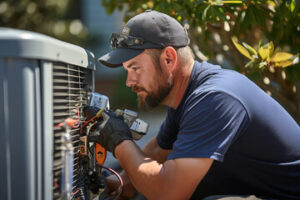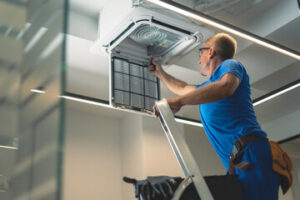Air conditioning systems play a vital role in maintaining indoor comfort, especially during hot summer months. However, like any mechanical system, air conditioners are susceptible to wear and tear over time, necessitating repairs to ensure optimal performance and efficiency.

In this comprehensive guide, we delve deep into the world of air conditioning repair, covering everything from common issues and troubleshooting techniques to DIY fixes and when to call in professional help. Contact the experts at Air Conditioning Repair Loveland OH if you need one.
Before diving into the intricacies of air conditioning repair, it’s essential to understand how these systems work. Air conditioners operate on the principles of refrigeration, utilizing a cycle of compression, condensation, expansion, and evaporation to remove heat from indoor spaces and maintain cool temperatures. The main components of an air conditioning system include the compressor, condenser, evaporator, expansion valve, and refrigerant lines. Understanding the function and interaction of these components is key to diagnosing and repairing common issues.
Common Air Conditioning Problems
- Insufficient Cooling: One of the most common issues homeowners encounter is insufficient cooling from their air conditioning system. This could be caused by various factors, including dirty air filters, refrigerant leaks, compressor issues, or inadequate insulation. Troubleshooting steps may include checking and replacing air filters, inspecting refrigerant levels, cleaning condenser coils, and assessing ductwork for leaks or damage.
- Airflow Restrictions: Restricted airflow can significantly impact the performance of an air conditioning system, leading to uneven cooling, reduced efficiency, and increased energy consumption. Common causes of airflow restrictions include dirty or blocked air vents, clogged air filters, obstructed condenser coils, and ductwork issues. Regular cleaning and maintenance of air vents, filters, and coils can help prevent airflow restrictions and ensure proper system operation.
- Refrigerant Leaks: Refrigerant leaks are a serious issue that can compromise the performance and efficiency of an air conditioning system. Signs of a refrigerant leak include reduced cooling capacity, ice buildup on the evaporator coil, and hissing or bubbling sounds coming from the refrigerant lines. Detecting and repairing refrigerant leaks requires specialized equipment and training, making it a job best left to professional HVAC technicians.
- Electrical Problems: Electrical issues such as faulty wiring, blown fuses, or malfunctioning capacitors can cause air conditioning systems to malfunction or fail altogether. Symptoms of electrical problems may include the system not turning on, frequent tripping of circuit breakers, or erratic behavior from the thermostat. Diagnosing and repairing electrical issues requires caution and expertise to ensure safety and prevent further damage to the system.
- Compressor Failure: The compressor is the heart of an air conditioning system, responsible for pressurizing and circulating refrigerant throughout the system. Compressor failure can result from various factors, including overheating, mechanical wear, electrical issues, or refrigerant leaks. Signs of compressor failure include loud noises, reduced cooling capacity, or the system not turning on at all. Repairing or replacing a compressor is a complex and costly endeavor, often requiring professional intervention.
DIY Air Conditioning Repairs
While some air conditioning repairs require the expertise of trained professionals, there are several DIY fixes that homeowners can tackle themselves:
- Changing Air Filters: Regularly changing air filters is one of the simplest yet most effective ways to maintain optimal airflow and system efficiency. Air filters should be replaced every one to three months, depending on usage and air quality.
- Cleaning Condenser Coils: Outdoor condenser coils can become dirty or clogged with debris over time, hindering heat transfer and reducing system efficiency. Cleaning condenser coils with a hose or soft brush can help restore proper airflow and cooling capacity.
- Clearing Air Vents: Blocked or obstructed air vents can restrict airflow and impede the performance of an air conditioning system. Regularly inspecting and clearing air vents of dust, dirt, or obstructions can help ensure even cooling throughout the home.
- Checking Thermostat Settings: Incorrect thermostat settings or programming errors can lead to temperature discrepancies and inefficient operation of the air conditioning system. Verifying thermostat settings and adjusting as needed can help improve comfort and energy efficiency.
- Inspecting Ductwork: Leaky or damaged ductwork can contribute to airflow restrictions and reduced system efficiency. Visual inspection of ductwork for signs of damage or leaks, such as visible gaps or disconnected sections, can help identify areas in need of repair or sealing.
When to Call a Professional
While DIY repairs can address minor issues, certain air conditioning problems require the expertise of trained professionals. Homeowners should consider calling a professional HVAC technician for the following situations:
- Refrigerant Leaks: Detecting and repairing refrigerant leaks requires specialized equipment and training to ensure proper handling and disposal of refrigerants. Professional technicians can safely diagnose and repair refrigerant leaks to restore system performance and efficiency.
- Electrical Issues: Electrical problems pose safety risks and should be addressed by qualified professionals to prevent injury or damage to the system. Professional HVAC technicians have the knowledge and experience to safely diagnose and repair electrical issues, ensuring the system operates safely and reliably.
- Compressor Failure: Compressor failure is a complex issue that often requires professional intervention due to the technical expertise and specialized equipment needed for diagnosis and repair. Professional technicians can assess the condition of the compressor and recommend appropriate repairs or replacements as needed.
- Warranty Considerations: Many air conditioning systems come with manufacturer warranties that may be voided if repairs are attempted by unqualified individuals. Homeowners should consult their warranty documentation and consider hiring professional technicians to ensure warranty coverage and compliance.
- System Upgrades or Replacement: In some cases, air conditioning systems may be beyond repair or nearing the end of their service life. Professional technicians can assess the condition of the system and recommend appropriate upgrades or replacements to improve efficiency, comfort, and longevity.
Air conditioning repair is a multifaceted endeavor that requires a combination of knowledge, skill, and expertise to diagnose and address common issues. Whether tackling DIY repairs or enlisting the help of professional HVAC technicians, homeowners can ensure the optimal performance and efficiency of their air conditioning systems by addressing problems in a timely and effective manner. By understanding the common issues, troubleshooting techniques, and when to seek professional help, homeowners can maintain comfort, convenience, and peace of mind throughout the hot summer months and beyond.
